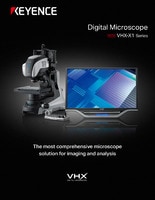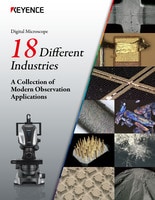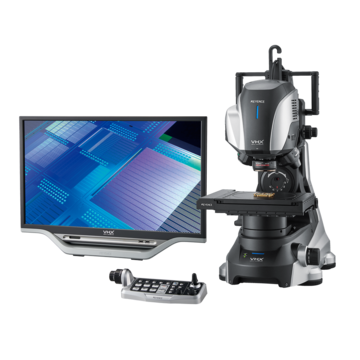Digital Microscopes
Observation and Analysis of Ceramic Materials
Ceramics are materials that have been around since before resin and metal. While ceramics are hard and resistant to friction and high temperatures, they have been considered unsuitable for use as a material for industrial parts due to their vulnerability to mechanical impacts and rapid temperature fluctuations.
However, in recent years, ceramics that have overcome these shortcomings have been developed and are now used in electrical assemblies (a typical example being multilayer ceramic capacitors (MLCCs)), heat-resistant bearings used in automotive and aircraft engines, building materials, and other key parts.
This section introduces examples of observation and analysis of ceramic material products done by our latest 4K digital microscope.
The Need for Observation and Analysis of Ceramic Material Products

Surface mounting on chip components became possible in the mid-1980s, which paved the way to use ceramic capacitors as chip components. Since then, ceramic capacitors have become smaller in size alongside the increasing integration density of PCB mounting. The sophisticated techniques and production systems that allow for accurate stacking of hundreds of dielectric sheet layers within a mere 1 μm have bolstered electronics in every field. Nevertheless, the miniaturized parts were more prone to having poor insulation between the internal electrodes due to cracks from warping PCBs and scratches in the dielectric sheets.
In terms of building materials, there are functional ceramic tiles with super hydrophilic and antifouling properties. Because ceramics used in building materials are required to be highly heat resistant and flame proof, composition analysis is essential for maintaining quality.
The need for observation and analysis of ceramic materials is increasing as the components they are used in become more sophisticated and complex.
Get detailed information on our products by downloading our catalog.
View Catalog

Examples of Observation of Ceramic Material Products Using Our Latest 4K Digital Microscope
In most cases, the surface of a ceramic material product has low contrast, which makes the surface difficult to observe using an optical microscope.
However, the VHX Series's high-resolution lens and 4k image sensor enables advanced observation of ceramics and other low-contrast materials.
Example of observing a multilayer ceramic capacitor (MLCC)
A MLCC uses hundreds of ceramic layers within 1 micron as dielectric sheets. The ceramics embedded in this small area can be observed by using abrasion to remove the packaging.
Even a minor crack present at mounting can develop into a larger crack from mechanical impacts and aging, and these larger cracks can lead to insulation failure. Poor insulation can result in component failure, heat generation, and/or fire. Overlooking fine cracks due to insufficient magnification or resolution has been a serious issue in the inspection process.
While minute exterior problems on ceramic material products tend to have low contrast that makes them difficult to observe, the VHX Series 4K Digital Microscope can observe such defects by comparing the images taken using both darkfield and brightfield lighting setups. This comparison enables a clear capture of cracks and insulation failures.
Even when the resin-coated sample had an uneven surface due to insufficient polishing, the deep depth of field provided by the high-resolution lens contributes to a clear imaging of even submicron-order cracks.
Observation of the internal electrodes of a ceramic capacitor using the VHX Series 4K Digital Microscope

Darkfield lighting

Brightfield lighting
Observation of glass fiber in ceramic building material
Glass fiber is a widely used inorganic material characterized by its heat and corrosion resistance as well as excellent elasticity and stiffness. High-functionality building materials have been developed by including glass fiber in the ceramic fibers. These materials have good heat insulation, heat resistance, and fire-proof properties. Some examples of their use can be seen in flame-retardant curtains and for sealing heat from boilers and other industrial furnaces.
Glass fiber woven into cotton-like materials has high peaks, deep valleys, and low contrast. These issues prevent accurate observation using conventional microscopes.
KEYENCE’s VHX Series high-definition 4K Digital Microscope adopts the latest technologies, including a high-resolution lens and a 4K CMOS. These technologies enable the VHX Series to observe and analyze glass fiber in ceramic building materials with clear 4K images.
The Depth Composition function can fully focus the entire target, regardless of its uneven surface. The High Dynamic Range (HDR) function captures multiple images at varying shutter speeds to obtain an image with high color gradation, thereby making it possible to perform observation with images sporting higher levels of detail and contrast, which were conventionally inaccessible due to limitations in resolution and contrast.
The VHX Series also supports 2D and 3D measurements with easy operation using high-resolution magnified images, which contributes to highly accurate, quick performance of the series of tasks required for analysis.
Observation of ceramic and glass fiber dispersion using the VHX Series Digital Microscope

Normal

HDR imaging
Observation of scratches on a ceramic edge surface
Conventional microscopes provided different views depending on the angle of lighting. These different views led to cases where scratches on low-contrast ceramic material edges were overlooked.
With the VHX Series, omnidirectional lighting data is automatically captured, and the most suitable image can be selected for additional analysis. Furthermore, after capturing the image the lighting direction can still be manipulated using the mouse, so scratches and other defects can be illuminated and observed.
Observation of scratches on a ceramic edge surface using the VHX Series 4K Digital Microscope

Conventional microscope

High-definition imaging with the VHX Series
We’re here to provide you with more details.
Reach out today!

One Microscope Supports Everything From Observation and Analysis to Report Generation

The VHX Series high-definition 4K Digital Microscope offers excellent efficiency compared to conventional optical and digital microscopes and makes it possible to eliminate human errors and ensure accurate observation and analysis.
The high-definition 4K images generated by cutting-edge optical image processing and automation techniques allow for automatic area measurement and counting on ceramic material products with simple operation. This contributes to producing quick, sophisticated analysis results every time.
The captured or measured data can be easily output as a report with a fixed format using the report function. This can be useful for not only quality assurance but also for identifying any problem that may arise and subsequent process improvements.
Equipped with many other advanced functions, the VHX Series can be a powerful partner for defect analysis of ceramic material products. For additional product info or inquiries, click the buttons below.
Get detailed information on our products by downloading our catalog.
View Catalog




